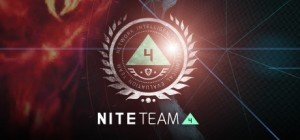Review for NITE Team 4 page 2
At the end of a few missions are “critical actions” in which you must choose what to do, such as whether to order a drone strike on a target. I can’t say whether or not this changes anything narratively significant, since the only way to replay a Story mission is apparently to reset the entire game. However, your actions do influence how well-regarded you are by various intelligence agencies around the world, based on the effects of your course of action. For instance, high collateral damage in a target country might decrease your influence with one or more agencies, while low collateral damage might increase your influence. There are various trade-offs that have to be considered, and this can lead to a feeling of tension as you decide what must be done.
There are also a few pure logic puzzles sprinkled throughout, highly reminiscent of the kinds of challenges that are the bread and butter of The Black Watchmen, with brief excursions to the internet yielding clues as to how to solve them. These puzzles, one of which involves studying acquired biometric data in order to figure out how to infiltrate a network, clearly serve to break up the hacking simulation monotony, but are very well-integrated into the experience and do not feel superfluous at all. While perhaps not necessary, they are welcome additions to the game and I enjoyed them.
During the game you are accompanied by several characters in the form of disembodied voices that communicate with you via the Stinger OS terminal. The most ubiquitous are Catherine Wheeler (a character familiar to players of The Black Watchmen) and Dylan Voorhees, both of whom narrate chapter introductions and serve a number of purposes in assisting and guiding you. The voice-overs are generally solid, though at times they literally sound like actors reading their lines and several phrases are actually voiced the way they appear on-screen, typos and all. For example, a phrase that should be “a whole lot more complicated” is written “a whole more complicated,” and voiced exactly as such. It’s a mild gripe, to be sure, but the effect is jarring enough that it’s surprising to me that these mistakes weren’t caught and corrected. Also, despite there being few serious time constraints except for vehicle tracking sequences and one section near the end, the characters will occasionally urge you to “work quickly,” presumably in a bid to heighten the tension. Instead, these encouragements did the opposite of what they are supposed to do, making me acutely aware that there is no time limit. Again, a minor issue, but it might have been better not to draw attention to the fact.
Open world missions are optional assignments that unlock in the main game approximately each month, at no additional charge to players. Based on real-world cyber security scenarios, these missions require you to do research on the internet (Google searches, that is, not actual hacking, of course) and then bring back what you find into the game. They are very similar to the way puzzles in The Black Watchmen work, but instead of internet research being the main focus of these missions (as in Black Watchmen), here your research yields the knowledge necessary to hack a target. I found them generally more difficult than the main story missions, and thus more time consuming, but the combination of puzzle styles is an interesting feature. Due to the increased challenge, however, an attendant increase in frustration kept me from fully enjoying them in large doses.
Other optional objectives called “Bounties” are quick, time-sensitive hacking jobs for various intelligence agencies around the world. These come and go on a rotational basis, and are available only for a defined period of time, from a few minutes to a few hours. The difficulty of these missions varies, the challenge seemingly rising with the amount of time you have to solve them. Succeeding in these changes your influence level with each spy agency involved. Completing a mission for one agency against another understandably increases your reputation with the first while decreasing it with the other. Like the Hivemind intel feature, the question of what purpose the reputation mechanic actually has on the game remains unanswered at this point. In any case, the bounty feature is enjoyable overall, especially when you just want a quick dose of hacking gameplay.
The player-made missions (requiring the “Network Administrator” DLC to create) located in what is called the Hivemind Network are a bit of a mystery. For the purposes of review I waded into this part of the game, but even as I solved a few of them, I didn’t really understand their purpose. It seems that you are supposed to hack into these networks, and for doing so you get access to a “marketplace” where you can use points or credits (which are, at this stage, finite and unreplaceable) to buy “intel.” What, exactly, can be done with this intel is unclear, however.
Although I personally found the presence of music to be somewhat distracting and muted it for much of my playthrough, the soundtrack itself is excellent. There are, in fact, two parts, the first composed by DORO Music and the second by Douglas Holmquist. Part 1 is around 30 minutes long and contains two downtempo ambient tunes and a pair of tense orchestral tracks, while Part 2 is nearly an hour long and is a single, morphing techno-ambient composition. Both scores are great, and quite appropriate for the game’s cyberpunk atmosphere. An audio menu option allows you to switch between the two. I appreciate being given the choice but take issue with the implementation, as the player is given no indication of what the alternative soundtrack is, and the change is so subtle at first that it is hard to notice anything is even different.
Sound effects are likewise excellent, and can be heard almost everywhere in the game. From electronic bloops and blips that accompany the launch (and closure) of the programs in your toolkit, to the dramatic fanfares that herald the completion of an objective, to the ever-present voice of FAY, the artificial intelligence platform that apparently underlies the system on which you perform your duties as a NITE Team 4 agent, the soundscape is surprisingly rich and immersive for what is at its core a DOS-style text parser housed within a fancy graphical environment. I enjoyed it immensely, finding it heightened the feeling of being a futuristic cyber-spy.
Here too there are only minor drawbacks, mainly that FAY’s monotone announcements (that you have opened one of your tools or begun an intrusion attempt, for instance) become extremely repetitive before long. Alleviating this somewhat is the ability to disable voice-overs when activating subsequent instances of a tool that’s already open (when, say, gathering information about two servers at the same time), but it would have been nice to completely switch off FAY’s tool announcements entirely. The AI’s voice-overs are also idiosyncratically applied, with some tools being called out by name upon being opened (“Foxacid server connection initiated”) and others heralded simply by stating their function (“Information gathering module initiated.”) Other tools, inexplicably, open with no voice-over announcement at all. While I admit that this is essentially more quibbling over minor details, it is a noticeable and inexplicable area where a lack of polish is evident.
Graphically NITE Team 4 resembles a high-tech computer desktop, with a menu for selecting tools and programs on the left-hand side, shortcuts to various important tools at the bottom, and an icon tray on the right that allows you to switch between multiple desktops and to drag and drop tool windows between them. Although things can get quite messy with multiple tools open at one time (an inevitability, due to having multiple avenues of investigation for a given task), it is possible to organize things so that you can have, say, information gathering tools on one desktop, XKEYSCORE on another, and so on. Most tools open into simple text-based windows, but the few that have their own GUIs look appropriately futuristic.
It is possible to unlock customizations for the interface, such as new color schemes, iconographic avatars and frames to represent the player (visible in the upper left of the desktop) and dress up the overall look and feel. Such options are numerous and represent a rather superfluous but enjoyable aspect of the game. Various conditions enable different features, and some appear to be so special they can only be unlocked once or not at all, such as watching a developer Twitch stream or backing the game’s development on Kickstarter.
The interface itself is controlled using a mixture of keyboard and mouse, and in general it works well. Some features, such as the Turbine C2 Registry (basically all the available servers you have hacked), are accessed and used via mouse, while most tools can either be opened using the left-hand menu or by typing the name of the tool into an open window, in which case a new window will launch.
There is one feature that I did not test at all, and that is the multiplayer option available for both Story Mode and the Hivemind network. At time of writing, a message still warned that this feature is in beta, and as such you may encounter “game breaking” bugs or glitches, with the only recourse to be to reset your game entirely. It seems to be a way for players to collaborate on missions in similar fashion to a proposed but never properly implemented feature in The Black Watchmen. If you do not wish to enable this feature, as I didn’t, you still have plenty of options for collaboration with fellow players, including forums and a Discord server.
Combining realistic, text-based tools with touches of futuristic flair, NITE Team 4 succeeds at creating a hacking simulator that feels quite grounded while putting the player in the cyber-warfare hotseat. The story is interesting in its own right, even if it does occasionally get lost among the string of immersive objectives. While the complex gameplay can be a handful with its numerous NSA-inspired tools, network intrusion, and data-gathering, the experience never feels overwhelming, rewarding players with the satisfying sense of being an elite hacker while minimizing the feeling of repetition, even seamlessly including some logic puzzles for a change of pace. Certain gameplay features lack a final bit of polish or a clear purpose, but given that the Academy and Story Mode missions alone provide over 25 hours of combined content that remains fresh to the end, with new and recurring standalone missions on top of that, this game is a must-have for every fan of Alice & Smith or hacker sims in general, serving as a great introduction to the genre for curious players looking for something out of the ordinary.
























